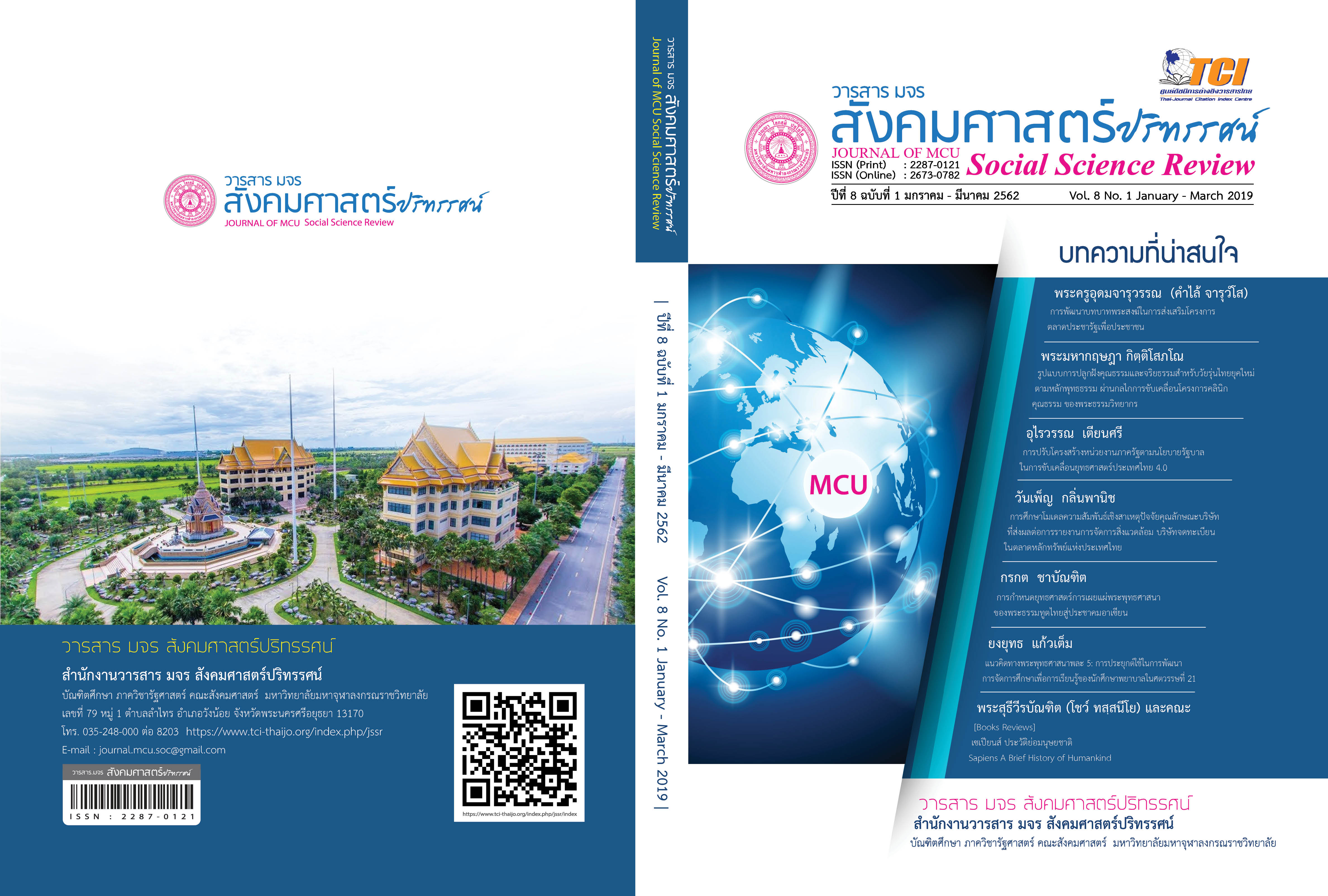การปรับโครงสร้างหน่วยงานภาครัฐตามนโยบายรัฐบาลในการขับเคลื่อนยุทธศาสตร์ ประเทศไทย 4.0
คำสำคัญ:
การปรับโครงสร้าง,การขับเคลื่อนยุทธศาสตร์, ประเทศไทย 4.0บทคัดย่อ
บทความวิจัยนี้มีวัตถุประสงค์ 1) เพื่อศึกษาสภาพการปรับโครงสร้างหน่วยงานภาครัฐตามนโยบายรัฐบาลในการขับเคลื่อนยุทธศาสตร์ประเทศไทย 4.0 2) เพื่อศึกษาองค์ประกอบที่ส่งผลต่อการปรับโครงสร้างหน่วยงานภาครัฐตามนโยบายรัฐบาลในการขับเคลื่อนยุทธศาสตร์ประเทศไทย 4.0 และ 3) เพื่อเสนอการปรับโครงสร้างหน่วยงานภาครัฐตามนโยบายรัฐบาลในการขับเคลื่อนยุทธศาสตร์ประเทศไทย 4.0
การวิจัยครั้งนี้เป็นการวิจัยเชิงคุณภาพ (Qualitative Research) ซึ่งเป็นการวิจัยเชิงคุณภาพเพื่ออธิบายปรากฏการณ์ของการเปลี่ยนแปลงในด้านโครงสร้างหน่วยงานภาครัฐตามนโยบายของรัฐบาลที่ผู้วิจัยได้ดำเนินการเก็บข้อมูล โดยการสัมภาษณ์เชิงลึก (In-depth interview) สังเกตการณ์แบบมีส่วนร่วม (Participant observation) สังเกตการณ์แบบไม่มีส่วนร่วม (Nonparticipant observation) และการสนทนากลุ่ม (Focus Group) และรวบรวมข้อมูลจากการศึกษาข้อมูลจากเอกสาร (Documentary research)
ผลการวิจัยพบว่า
1) ด้านความพร้อมของระบบราชการ การบริหารราชการจะต้องมีความพร้อมและทำให้เกิดผลสัมฤทธิ์ต่อหน่วยงานของรัฐ 2) ด้านกฎระเบียบ และขั้นตอนในการบริหารงาน ในการดำเนินงานของภาครัฐควรลดเลิกภารกิจและยุบหน่วยงานที่ไม่จำเป็น 3) ด้านการขาดบุคลากรที่มีศักยภาพ และความเป็นมืออาชีพ ถือเป็นเรื่องสำคัญยิ่งในการทำงานของหน่วยงานภาครัฐ
ซึ่งข้าราชการและเจ้าหน้าที่ของรัฐจะต้องมีความรู้ความชำนาญ 4) ด้านภาพลักษณ์ขององค์การและความรับผิดชอบต่อหน้าที่ของข้าราชการ ควรมีการปรับเปลี่ยนวัฒนธรรม ค่านิยมและจะต้องปรับตัวในการทำงานให้มีความรับผิดชอบต่อสาธารณะ และ 5) ด้านโครงสร้างของหน่วยงานภาครัฐ ซึ่งพบว่าโครงสร้างของหน่วยงานภาครัฐในปัจจุบันมีลักษณะที่ไม่ยืดหยุ่น ยึดติดกับกรอบตามอำนาจหน้าที่ที่กฎหมายกำหนดเป็นหลัก
เอกสารอ้างอิง
Bass, Bernard M., and Ronalald E. Riggio.(2006). Transformational Leadership. 2 nded. New Jersey:LawrenceEribaum Associates. Inc.
Hollander, E.P. Leadership in Dynamics : A Practical Guide to Effective Relationship. New York : Free Press, (1978).
House, R.J. and R. R. Mitchell. (1974). “Path-goal theory of leadership” Journal of
Contemporary Business. 3 (8) : 81 – 97.
Sirisamphan, T. (2017). Bureaucracy System Driving through Government 4.0. Office of the Public Sector Development Commission.
Lorsuwanrat. T. (2010). Knowledge Organization ; From Concept to Practice. Bangkok: Saphire Printing.
Kangsanan, K (2006). Decision Proceessing in Administration and General Conceptual Framework. Bangkok. Baanasankanpattana. (45-60).
Ketsuwan, R. (2013). New Public Management. Bhaphit Printing, Bangkok.
National Economics and Social Development Board, Offfice of (NESDB). (on-line) from http://prachatai.com/journal/2016/07/67040Sat, 2016-07-23 22:45) 20 March 2017.
Pinaisup, B. (2012) Trend of Organizational Management Changing and Role of Personal in Thailand Organization in 2027 A.D. Faculty of Public Administration, National Institute of Development Administration.
Public Sector Development Commission, Office of. (2013) Strategic Plan in Development of Thai Bureaucracy System (2013-2018 AD.). Vision Print and Media, Bangkok.
Ratanasak, T. (2012). Thai Bureaucracy Administration, Political Science and Public Administration, Chiengmai University.
Rakkhwamsuk, E.,(2016). Qualitative Research, Principle and Practice. Bangkok, DuanTula Printed .(in Thai)
Rakkhwamsuk, E.,(2017). New Public Service by Provincial Parliamentary Office, Humanities and Social Sciences Western University Vol.3 No.1 (January - April 2017).
ดาวน์โหลด
เผยแพร่แล้ว
รูปแบบการอ้างอิง
ฉบับ
ประเภทบทความ
สัญญาอนุญาต
ลิขสิทธิ์ (c) 2019 วารสาร มจร สังคมศาสตร์ปริทรรศน์

อนุญาตภายใต้เงื่อนไข Creative Commons Attribution-NonCommercial-NoDerivatives 4.0 International License.
เพื่อให้เป็นไปตามกฎหมายลิขสิทธิ์ ผู้นิพนธ์ทุกท่านต้องลงลายมือชื่อในแบบฟอร์มใบมอบลิขสิทธิ์บทความให้แก่วารสารฯ พร้อมกับบทความต้นฉบับที่ได้แก้ไขครั้งสุดท้าย นอกจากนี้ ผู้นิพนธ์ทุกท่านต้องยืนยันว่าบทความต้นฉบับที่ส่งมาตีพิมพ์นั้น ได้ส่งมาตีพิมพ์เฉพาะในวารสาร มจร สังคมศาสตร์ปริทรรศน์ เพียงแห่งเดียวเท่านั้น หากมีการใช้ภาพหรือตารางหรือเนื้อหาอื่นๆ ของผู้นิพนธ์อื่นที่ปรากฏในสิ่งตีพิมพ์อื่นมาแล้ว ผู้นิพนธ์ต้องขออนุญาตเจ้าของลิขสิทธิ์ก่อน พร้อมทั้งแสดงหนังสือที่ได้รับการยินยอมต่อบรรณาธิการ ก่อนที่บทความจะได้รับการตีพิมพ์ หากไม่เป็นไปตามข้อกำหนดเบื้องต้น ทางวารสารจะถอดบทความของท่านออกโดยไม่มีข้อยกเว้นใดๆ ทั้งสิ้น





